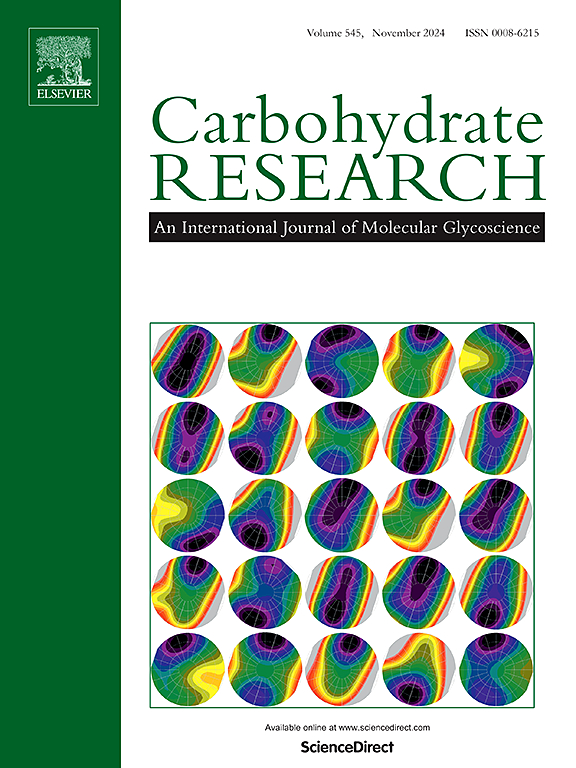Structural elucidation of the O-antigen polysaccharide from shigatoxin-producing E. coli O179 using genetic information, NMR spectroscopy and the CASPER program
IF 2.4
3区 化学
Q3 BIOCHEMISTRY & MOLECULAR BIOLOGY
引用次数: 0
Abstract
The serological properties of the O-antigen polysaccharide region of the lipopolysaccharides are used to differentiate E. coli strains into serogroups. In this study, we report the structure elucidation of the O-specific chain of E. coli O179 using NMR data, the program CASPER and analysis of biosynthetic information available in the E. coli O-antigen Database (ECODAB). The presence of genes that encode enzymes involved in the biosynthesis of the GDP-Man and UDP-GlcA within the O-antigen gene cluster of the bacteria indicates that the corresponding residues could be present in the polysaccharide. Furthermore, the occurrence of four genes that encode for glycosyltransferases indicates that the polysaccharide is composed of pentasaccharide repeating units; a bioinformatics approach based on predictive glycosyltransferase functions present in ECODAB revealed that the β-d-Manp-(1→4)-β-d-Manp-(1→3)-d-GlcpNAc structural element could be present in the O-specific chain. NMR spectroscopy data obtained from homonuclear and heteronuclear 2D NMR spectra (1H,1H-TOCSY, 1H,13C-HSQC, 1H,13C-H2BC and 1H,13C-HMBC) were analyzed using the CASPER program, revealing the following arrangement of monosaccharide residues as the most probable structure: →4)-α-d-GlcpA-(1→3)-[β-d-Glcp-(1→2)]β-d-Manp-(1→4)-β-d-Manp-(1→3)-β-d-GlcpNAc-(1→, which was further confirmed using 2D homonuclear 1H,1H-COSY and 1H,1H-NOESY spectra. The functions of the α-gluconosyltransferase and the β-glucosyltransferase were predicted using structural alignment of AlphaFold-predicted 3D structures. This O-antigen polysaccharide shares structural similarities with those of E. coli O6 and O188, S. boydii type 16, and the capsular polysaccharide of E. coli K43, explaining the serological cross-reactivities observed with strains belonging these O- and K-antigen groups.

利用遗传信息、核磁共振光谱和CASPER程序对产志贺毒素大肠杆菌O179的o抗原多糖进行结构分析。
脂多糖的o抗原多糖区域的血清学特性被用来区分大肠杆菌菌株的血清群。在这项研究中,我们利用核磁共振数据、CASPER程序和大肠杆菌o抗原数据库(ECODAB)中的生物合成信息分析,报道了大肠杆菌O179 o特异性链的结构解析。细菌的o抗原基因簇中存在编码参与GDP-Man和UDP-GlcA生物合成的酶的基因,表明多糖中可能存在相应的残基。此外,编码糖基转移酶的四个基因的出现表明多糖是由五糖重复单元组成的;基于ECODAB中存在的预测糖基转移酶功能的生物信息学方法显示,β-d-Manp-(1→4)-β-d-Manp-(1→3)-d- glcpnac结构元件可能存在于o特异性链中。利用CASPER程序对同核和异核二维核磁共振波谱(1H,1H- tocsy,1H,13C-HSQC, 1H,13C-H2BC和1H,13C-HMBC)数据进行分析,发现单糖残基最可能的结构为:→4)-α-d- glcpa -(1→3)-[β-d-Glcp-(1→2)]β-d-Manp-(1→4)-β-d-Manp-(1→3)-β-d- glcpnac -(1→3)-β-d- glcpnac -(1→),并通过二维同核1H,1H- cosy和1H,1H- noesy谱进一步证实。利用alphafold预测的三维结构对α-葡萄糖基转移酶和β-葡萄糖基转移酶的功能进行了预测。这种O抗原多糖与大肠杆菌O6和O188、S. boydii型16和大肠杆菌K43的荚膜多糖具有结构相似性,这解释了与属于这些O和k抗原群的菌株观察到的血清学交叉反应。
本文章由计算机程序翻译,如有差异,请以英文原文为准。
求助全文
约1分钟内获得全文
求助全文
来源期刊

Carbohydrate Research
化学-生化与分子生物学
CiteScore
5.00
自引率
3.20%
发文量
183
审稿时长
3.6 weeks
期刊介绍:
Carbohydrate Research publishes reports of original research in the following areas of carbohydrate science: action of enzymes, analytical chemistry, biochemistry (biosynthesis, degradation, structural and functional biochemistry, conformation, molecular recognition, enzyme mechanisms, carbohydrate-processing enzymes, including glycosidases and glycosyltransferases), chemical synthesis, isolation of natural products, physicochemical studies, reactions and their mechanisms, the study of structures and stereochemistry, and technological aspects.
Papers on polysaccharides should have a "molecular" component; that is a paper on new or modified polysaccharides should include structural information and characterization in addition to the usual studies of rheological properties and the like. A paper on a new, naturally occurring polysaccharide should include structural information, defining monosaccharide components and linkage sequence.
Papers devoted wholly or partly to X-ray crystallographic studies, or to computational aspects (molecular mechanics or molecular orbital calculations, simulations via molecular dynamics), will be considered if they meet certain criteria. For computational papers the requirements are that the methods used be specified in sufficient detail to permit replication of the results, and that the conclusions be shown to have relevance to experimental observations - the authors'' own data or data from the literature. Specific directions for the presentation of X-ray data are given below under Results and "discussion".
 求助内容:
求助内容: 应助结果提醒方式:
应助结果提醒方式:


